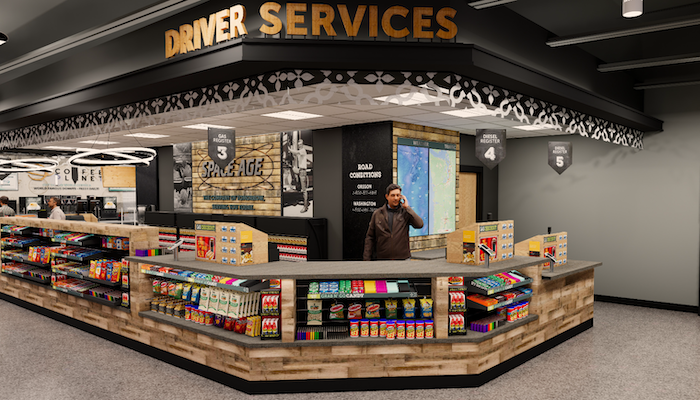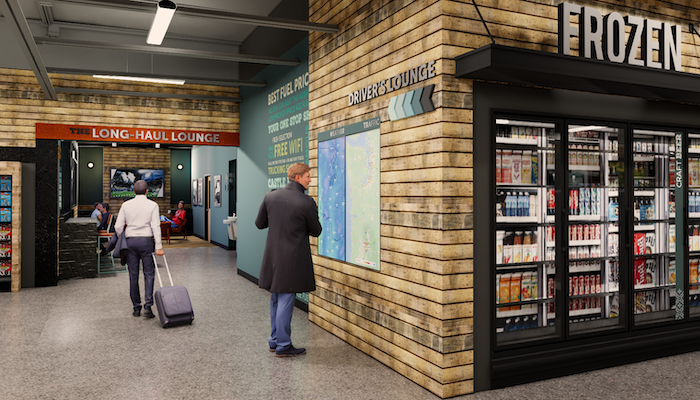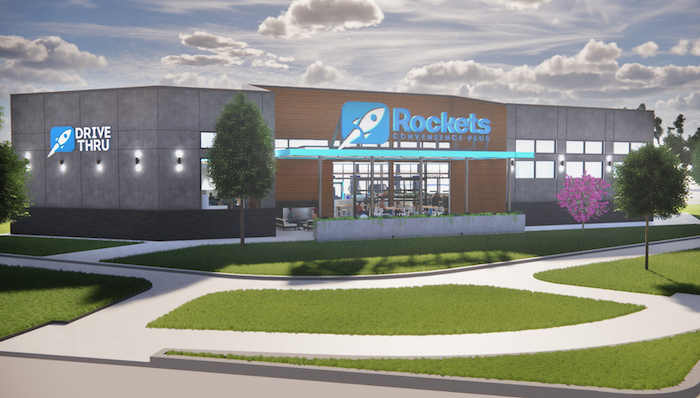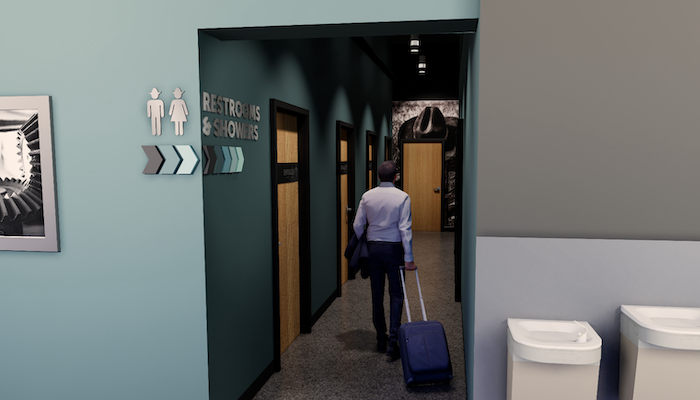
Modern truck stops aren’t just for long-haul drivers looking for a place to rest and refuel—they’re evolving into community spaces where visitors can relax, enjoy a good meal, and even find entertainment. The push for these upgrades in designing truck stops comes from the need to provide more amenities and a welcoming environment that meets the diverse needs of today’s travelers, whether they’re professional drivers or families on a road trip. Innovative retail operators are thinking bigger, reimagining what a truck stop can be and turning them into much more than just pit stops.
Key Elements of Designing Truck Stops
Efficient Layouts
An efficient layout is crucial for a successful truck stop. This includes easy access and exit points, ample parking spaces, and a logical flow of traffic. A well-designed layout helps reduce congestion and ensures that drivers can quickly find what they need. Clear signage and marked pathways are essential for guiding drivers to the necessary services without confusion.
Additionally, the layout should consider the needs of different types of vehicles, from large trucks to smaller passenger cars. Separate parking areas for trucks and cars can help manage traffic flow and prevent bottlenecks. Incorporating green spaces and rest areas within the layout can provide much-needed relaxation spots for weary travelers.
Inside, the layout is just as important. Truck stops follow similar design principles as other retail and service locations. For example, proper aisle size and clear signage are essential. Consulting with a designer ensures best practices are followed for an efficient and welcoming environment.
Amenities and Services
Modern truck stops offer a wide range of amenities and services to cater to the needs of travelers. These can include:
- Clean Restrooms: Well-maintained and hygienic restrooms are a must. Frequent cleaning schedules and high-quality fixtures ensure a pleasant experience for all visitors.
- Dining Options: From fast food to sit-down restaurants, offering a variety of dining choices is essential. Some truck stops even feature specialty food vendors and local cuisine to provide a unique dining experience.
- Convenience Stores: Stocked with snacks, beverages, and essential supplies. These stores often carry travel necessities, automotive supplies, and even regional souvenirs.
- Lounge Areas: Comfortable seating areas where drivers can relax and unwind. Some lounges are equipped with entertainment options like TVs, games, and reading materials.
- Showers and Laundry: Facilities for personal hygiene and laundry services. Clean, private showers and on-site laundry machines help drivers stay refreshed on long journeys.
- Fitness Centers: A place for travelers to exercise and stay fit on the road. These centers often include basic gym equipment, yoga mats, and sometimes even swimming pools.

Safety and Security
Safety is a top priority in modern truck stop designs. Security measures such as surveillance cameras, well-lit parking areas, and secure entry points help ensure the safety of both drivers and their vehicles. Additionally, having on-site security personnel can provide an added layer of protection and peace of mind.
Emergency services and first-aid stations are also crucial components of a secure truck stop. Clearly marked emergency exits and easy access to medical assistance can make a significant difference in critical situations. Creating a safe environment encourages more drivers to use the facilities regularly.
Eco-Friendly Features
Sustainability is becoming increasingly important in truck stop design. Eco-friendly features such as solar panels, energy-efficient lighting, and recycling programs not only reduce the environmental impact but also attract environmentally conscious travelers. Green roofing, rainwater harvesting systems, and electric vehicle charging stations are additional features that contribute to sustainability.
Using sustainable building materials and implementing energy-saving technologies can significantly reduce the carbon footprint of truck stops. These eco-friendly practices not only benefit the environment but also reduce operational costs in the long run. Truck stops that prioritize sustainability can set a positive example and lead the industry towards a greener future.
Modern Guidelines for Designing Truck Stops

Accessibility
Accessibility is a key consideration when designing truck stops. This includes providing easy access for large trucks, as well as ensuring that facilities are accessible to people with disabilities. Wide driveways, spacious parking areas, and ramps are essential features. Ensuring that all areas, including restrooms and dining facilities, are wheelchair accessible is crucial for inclusivity.
Furthermore, clear and visible signage helps all visitors navigate the truck stop with ease. Providing designated parking spaces for disabled drivers and ensuring that pathways are free of obstacles can greatly enhance accessibility. Thoughtful design can make truck stops welcoming and accommodating to everyone.
Efficient Use of Space
Maximizing the use of available space is crucial. This can be achieved through smart design and layout planning. Multi-level parking structures, compact building designs, and efficient use of land can help make the most of the available space. Utilizing vertical space and modular construction techniques can create more room for amenities without expanding the footprint.
Innovative designs can also incorporate flexible spaces that can be adapted for different uses. For example, areas that serve as parking during peak hours can be transformed into event spaces or markets during off-peak times. Such versatility ensures that every square foot is used effectively.
Comfort and Convenience

Comfort and convenience are at the heart of modern truck stop designs. This includes providing comfortable seating, clean restrooms, and easy access to amenities. Thoughtful design elements such as shaded areas, well-placed seating, and easy-to-read signage contribute to a positive experience. Providing free Wi-Fi and charging stations can also enhance comfort and convenience for travelers.
In addition, offering family-friendly facilities such as playgrounds, pet areas, and nursing rooms can make truck stops more appealing to a wider range of travelers. These amenities ensure that everyone, from solo drivers to families, can find what they need for a comfortable journey.
Technology Integration
Technology plays a significant role in modern truck stop designs. Features such as free Wi-Fi, charging stations, and digital information boards enhance the overall experience for travelers. Additionally, contactless payment options and mobile apps for ordering food and services add to the convenience. Real-time updates on fuel prices, parking availability, and traffic conditions can help drivers plan their stops more efficiently.
Innovative truck stops are also exploring the use of smart sensors and IoT devices to monitor and manage facilities. These technologies can improve maintenance efficiency, reduce energy consumption, and provide valuable data for further improvements. The integration of technology ensures that truck stops stay ahead in an increasingly digital world.
Summary
Modern truck stops aren’t just for long-haul drivers looking for a place to rest and refuel—they’re evolving into community spaces where visitors can relax, enjoy a good meal, and find entertainment. Innovative retail operators are reimagining truck stops, transforming them into dynamic environments that meet the diverse needs of travelers.
Thoughtful truck stop design prioritizes layout, amenities, safety, accessibility, and sustainability, creating an inviting, convenient, and memorable experience for all visitors.
Key Elements of Designing Truck Stops
- Efficient layouts with clear traffic flow, ample parking, and accessible entrances.
- Comprehensive amenities: restrooms, dining, convenience stores, lounges, showers, fitness centers.
- Safety and security measures, including surveillance, well-lit areas, and emergency services.
- Eco-friendly and sustainable features like solar panels, energy-efficient lighting, and EV charging stations.
- Accessible facilities for all users, including ADA-compliant design and clear signage.
- Comfort and convenience: seating, Wi-Fi, charging stations, family-friendly amenities.
- Integration of technology: smart sensors, IoT monitoring, mobile apps, and digital signage.
Frequently Asked Questions
Q. Why are modern truck stops more than just refueling stations?
A. Modern truck stops are designed as community spaces with amenities such as dining, lounges, entertainment, and family-friendly areas, providing comfort and convenience for a wide range of travelers.
Q. What are the key considerations for truck stop layouts?
A. Efficient layouts should include clear traffic flow, separate parking for trucks and cars, easy access and exits, and strategically placed amenities to ensure smooth navigation and convenience for all visitors.
Q. Which amenities are essential in modern truck stops?
A. Key amenities include clean restrooms, dining options, convenience stores, lounges, showers, laundry facilities, and fitness centers, catering to both professional drivers and families.
Q. How can truck stops improve safety and security?
A. Safety measures include surveillance cameras, well-lit parking areas, emergency services, secure entry points, and on-site security personnel to protect both visitors and vehicles.
Q. What role does sustainability play in truck stop design?
A. Eco-friendly features like solar panels, energy-efficient lighting, green roofing, and EV charging stations reduce environmental impact and operational costs while attracting environmentally conscious travelers.
Q. Why is technology integration important in modern truck stops?
A. Technology such as Wi-Fi, charging stations, smart sensors, IoT monitoring, mobile apps, and digital signage improves convenience, maintenance efficiency, and overall customer experience.
